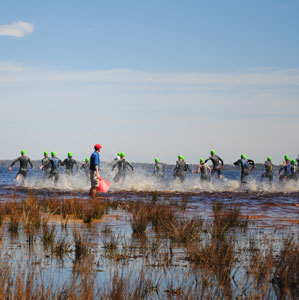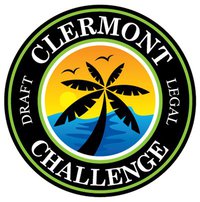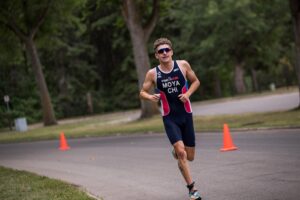Draft legal age group racing in FL

If you ever wanted to know what racing is like for the ITU Pros, you now have your chance to test those waters at the Draft Legal Challenge in Clermont, FL on March 5th. Jarrod Shoemaker is the brains behind the Draft Legal Challenge, and he talked to slowtwitch about this new event.
Slowtwitch: How did the idea for a draft legal race for age groupers come up?
Jarrod: This has been something that I have wanted to do for a couple of years. There are several reasons behind it, first, I wanted to give age groupers the chance to do something different and second, for the first time in a USAT sanctioned event age groupers will get to feel what it is like in a pro draft legal race. Draft legal racing is so much different than non-draft racing and puts a major emphasis on all three legs of the race. It is really a different challenge and a different philosophy of racing, you have to be present through out the entire race, there is no getting comfy on the swim or bike.
ST: Why do you think it hasn?t happened before?
Jarrod: That is a good question and I think the best answer for that one is that it has happened before, but USAT has never sanctioned the race. There are small races that local tri clubs have put on that are draft legal but never anything with USAT?s backing. Besides that the major challenge is logistics, you have to space things out so much more. We have races starting at 7am and ending at 7pm! And the biggest thing is that roads must be closed, which makes a place like Lake Louisa State Park the perfect setting.
ST: How much of a struggle was it to get USAT to come on board with the Draft Legal Challenge?
Jarrod: It was not a struggle at all. I approached USAT?s sanctioning group with my race director Bill Burnett (http://www.cohassettri.com/series.php) and we had several things going for us, the biggest being that I had helped get an Elite Development Series Race at the same site last year. Since USAT knew me, and also that Bill runs races with a few thousand people up in Massachusetts with an emphasis on safety, they were willing to give it a try. After the race we are planning on meeting with them again and seeing how the experience went and whether it is something that makes sense to offer on a limited basis.
ST: So I guess this Clermont race in March is considered somewhat of a testing ground for more events along those lines?
Jarrod: Exactly, this race will be a big testing ground for future age group draft legal races. Until now the only athletes who could race draft legal were the pros and juniors. There were a few Elite Development Races that we staged last year where athletes had to be under 23 or could apply for acceptance if they were slightly older; however, the goal of those races was to bring post collegiate athletes into the draft legal pipeline. My vision for this race is quite different, I want this race to be an all comers race. It has turned a bit into another EDR race since it will be a pro qualifier for the top 3 finishers but we have a large age range from 16 up to 50 years old! We really hope to get racers from around the country to come down here to Florida and the National Training Center and race in the warm weather.
ST: Field size is most likely going to be a factor. How are you guys addressing this topic and what are the field limits?
Jarrod: Field limits are the biggest challenge for a draft legal race. 75 is really the maximum people that you can comfortably put onto the course, especially with a looped bike set up like we have. If you had an out and back bike you could do more, but you really don?t want to see packs of more than 50 cyclists ever, especially on one-lane roads. We decided to make this race 75 men and 75 women, first come, first served. We want this race to be something that is exclusive because it is not something that a triathlete can go do everyday.

ST: It is one thing to have a draft legal race with seasoned Pros, but with less skilled age groupers are there safety concerns and how are they addressed?
Jarrod: Great question and this is something that Bill and I have been working on since Day 1. Our choice of venue is the most important piece of that puzzle, with Lake Louisa having well paved wide roads with great lines of sight that piece should be very safe. We also will be holding a mandatory clinic will all participants and all athletes MUST race with road handlebars, no extended TT bars will be allowed. Of course aero bars that do not extend past the brake hoods are allowed. For me safety is always #1 and I feel that this race will actually be safer than most triathlons because athletes riding on road bikes provides better turning and braking than TT bars.
ST: In an ITU race most of the Pros swim reasonably well and are at least on the same loop of the bike to start with. It would seem that there easily could be some confusion when slow swimmers join those cyclists who already are on the second lap of the bike.
Jarrod: One of the rules in regards to safety is that athletes who are lapped on the bike will be pulled from the race. We are deciding on a 2, 3 or 4 lap bike course. Basically with a 3 lap course an athlete would have to be 8-10 minutes behind to be lapped. I think with a 750m swim we will have 3-4 minutes of separation between first and last swimmers but not much more than that. The goal is to make sure that people have fun trying this out and that it is safe.
ST: It seems you are already working on your post Pro career. 🙂
Jarrod: I guess you could say that. I hope my pro career will be quite long and after 2016 I can have a great Ironman or 70.3 career as well. For me it is about making sure the sport is in a better place than when I found it. I want to make sure that after I retire we have USA athletes winning medals at the Olympics, I want to make sure that age group athletes have the opportunity to race in as many different races as possible and I want to make sure that the sport continues to grow and become recognized world wide. It might seem a bit idealistic, but the future professional athletes are knocking at the door and I want to make sure that they have a better opportunity for sponsors and exposure than I do. I think one of the best ways of doing that is to make sure that age groupers have a chance to race the way that the athletes in the Olympic pipeline get to race.
ST: Talking about racing, how are your preparations going for the 2011 season?
Jarrod: I have a much pared down race schedule and will base myself in the US for the summer. The European experiment last year went dreadfully wrong and affected the end of my season. This winter it took a long time to recover, but I am in full swing hard training now. My coach, Tim Crowley, along with the rest of the A-Team and I have been thinking really far outside the box. We consulted with a sports physiologist last November and he gave us some amazing insights and ideas. That is probably too much info as it is, our #1 rule is no data, but needless to say I am very excited to start the season off on the right foot this year instead of getting a puncture flat in Sydney.
ST: Anything else new and exciting?
Jarrod: Nope, nothing really exciting except that the weather is beautiful here in Clermont, FL!
ST: Thanks for your time.
Jarrod: No worries, we are really excited to put on this race!
The race website is draftlegalchallenge.com







Start the discussion at forum.slowtwitch.com